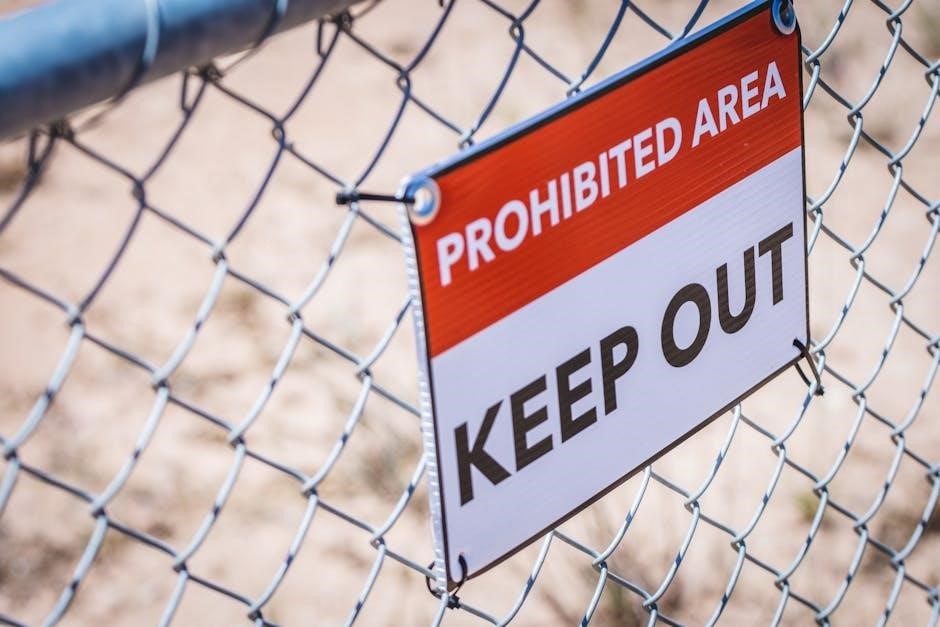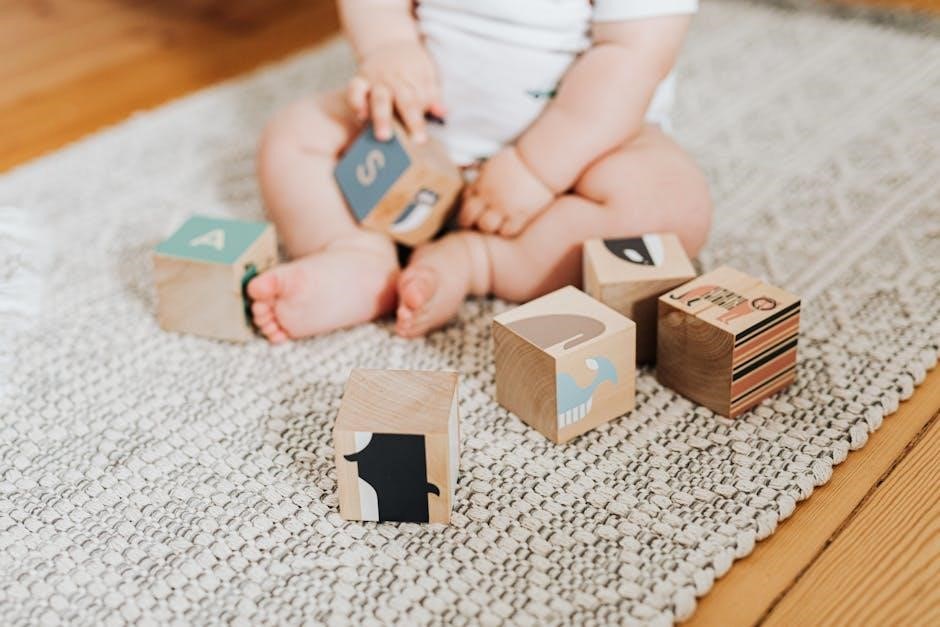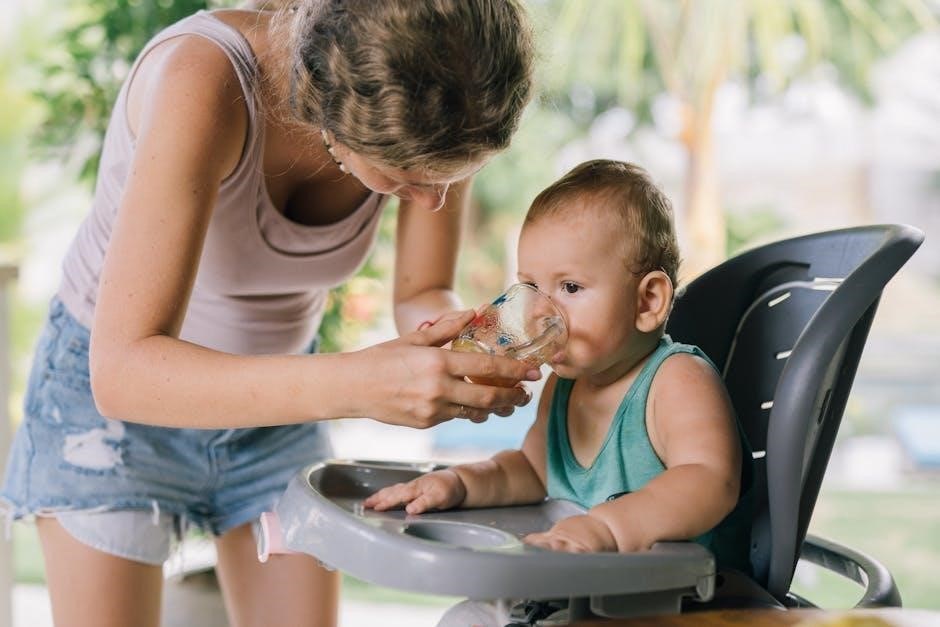Safety 1st Baby Gate Manual: A Comprehensive Guide
Welcome to your definitive resource for understanding and utilizing your Safety 1st baby gate! This guide offers comprehensive information extracted from available manuals. We aim to provide you with expert guidance for safe use.
Safety 1st baby gates are essential safety devices designed to protect young children from hazardous areas within the home. These gates prevent access to stairs‚ kitchens‚ and other potentially dangerous spaces‚ offering peace of mind to parents and caregivers.
Safety 1st‚ a trusted brand in child safety products‚ offers a variety of gate models to suit different needs and home layouts. Understanding the features and proper usage of these gates is crucial for ensuring the safety and well-being of your child.
This manual serves as a guide to help you navigate the selection‚ installation‚ and maintenance of your Safety 1st baby gate. It encompasses key information extracted from official Safety 1st manuals and related resources;
Always remember that while baby gates provide a significant safety barrier‚ they are not a substitute for attentive adult supervision. Regular checks and adherence to safety guidelines are essential for maintaining a safe environment for your child. This introduction will equip you with foundational knowledge.
Understanding the Importance of Baby Gates
Baby gates are indispensable tools for creating a secure environment for infants and toddlers. They act as physical barriers‚ preventing children from accessing areas where potential hazards exist. Stairs‚ with their risk of falls‚ are a primary concern‚ making baby gates essential for homes with multiple levels.
Kitchens‚ too‚ pose numerous dangers‚ including hot stoves‚ sharp objects‚ and cleaning chemicals. Baby gates can effectively block access to these areas‚ protecting children from burns‚ cuts‚ and accidental ingestion of harmful substances.
Furthermore‚ baby gates can be used to restrict access to other areas‚ such as home offices with electrical equipment or storage rooms containing potentially hazardous materials. By strategically placing baby gates‚ parents can create safe zones where children can play and explore without risk.
The use of baby gates significantly reduces the likelihood of accidents and injuries‚ providing parents with greater peace of mind. Always adhere to the manufacturer’s instructions for proper installation and usage.
Types of Safety 1st Baby Gates
Safety 1st offers diverse baby gates to suit various needs and home layouts. Pressure-mounted gates are popular for their ease of installation‚ using pressure to stay in place without hardware. These gates are ideal for temporary use between rooms but are not recommended for stairways.

Hardware-mounted gates provide a more secure and permanent solution. Screwed into the wall‚ they offer greater stability and are suitable for stairways and high-traffic areas. Retractable gates offer a space-saving option‚ disappearing when not in use.

Walk-through gates feature a door‚ allowing adults to pass through easily without removing the entire gate. Extra-wide gates accommodate larger openings‚ while tall gates provide added security for adventurous toddlers.
Consider your specific needs and the location where the gate will be installed when selecting a Safety 1st baby gate. Always refer to the product manual for detailed information and proper installation instructions to ensure the safety of your child.

Installation Guide
This section provides detailed instructions for installing your Safety 1st baby gate. Follow these steps carefully to ensure proper setup and a secure barrier for your child’s safety‚ always use the product manual.
Preparing for Installation
Before commencing the installation of your Safety 1st baby gate‚ meticulous preparation is crucial for ensuring a secure and effective barrier. Begin by carefully reviewing the specific instructions included with your particular Safety 1st gate model. Different models may have unique installation requirements.
Next‚ accurately measure the width of the opening where you intend to install the gate. This measurement will help you determine if the gate fits the space directly or if you need to use extension kits‚ if available. Gather all necessary tools‚ such as a screwdriver‚ level‚ and possibly a drill‚ depending on the model. Ensure you have all the gate components‚ including the gate itself‚ mounting hardware‚ and any adjustment tools.
Finally‚ inspect the installation area for any obstructions or uneven surfaces. The mounting surface must be solid and stable to ensure the gate is securely anchored. Clear the area of any debris or items that could interfere with the installation process. Proper preparation is key to a successful and safe installation.
Step-by-Step Installation Instructions (Specific Model)
Step 1: Position the gate within the doorway or opening. Ensure it’s centered and level. For pressure-mounted gates‚ gently expand the gate until it makes contact with both sides of the opening.
Step 2: If your gate requires hardware mounting‚ mark the positions for screws or bolts. Use a level to ensure accurate placement. Drill pilot holes if necessary.
Step 3: Attach the mounting hardware to the wall or door frame using screws or bolts. Ensure they are firmly secured.
Step 4: For pressure-mounted gates‚ gradually increase the pressure by turning the adjustment knobs. Ensure the gate is stable and secure.
Step 5: Test the gate’s locking mechanism to ensure it functions correctly. The gate should latch securely and be easy to open for adults but difficult for children.
Step 6: Double-check all connections and adjustments to guarantee the gate is firmly in place and meets safety standards. Refer to the manual’s diagrams;

Adjusting and Securing the Gate
Once the initial installation is complete‚ fine-tuning your Safety 1st baby gate is essential for optimal security and functionality. Begin by verifying the gate’s alignment; it should be perfectly vertical and horizontal‚ ensuring smooth operation. Use a level to confirm this.
For pressure-mounted gates‚ adjust the tension knobs on either side. Tighten them incrementally until the gate feels stable and resists movement. Avoid over-tightening‚ as this can damage the frame or the surrounding walls. Periodically re-tighten these knobs‚ as pressure can naturally decrease over time.

If you have a hardware-mounted gate‚ inspect the screws and bolts securing it to the wall or door frame. Ensure they remain snug and haven’t loosened. If necessary‚ tighten them carefully. Also‚ check the locking mechanism. It should engage smoothly and securely. Lubricate the latch with a silicone-based lubricant if it feels stiff or sticky.
Finally‚ test the gate by gently pushing and pulling on it to ensure it remains firmly in place. A properly adjusted and secured gate provides a safe barrier for your child.

Using and Maintaining Your Safety 1st Baby Gate
Properly using and maintaining your Safety 1st baby gate ensures long-lasting safety and functionality. Regular checks and cleaning are crucial. Familiarize yourself with the locking mechanism and address any issues promptly to guarantee your child’s safety.

Operating the Locking Mechanism

Understanding the locking mechanism of your Safety 1st baby gate is paramount for ensuring your child’s safety. Different models feature various locking systems‚ such as SecureTech indicators or dual-locking mechanisms‚ each requiring a specific operational approach. Always consult your specific model’s manual for detailed instructions.
Familiarize yourself with the proper engagement and disengagement procedures. Ensure the gate locks securely every time it’s closed. A properly locked gate prevents accidental openings and keeps your child safely contained. Practice operating the lock until it becomes second nature‚ allowing for quick and reliable use.
Pay attention to any visual or auditory cues that indicate a successful lock. Some gates feature indicators that change color or emit a click sound when securely fastened. Regularly inspect the locking components for wear and tear and address any issues immediately to maintain optimal performance and guarantee maximum safety for your little one.
Regular Safety Checks and Maintenance
Maintaining the integrity of your Safety 1st baby gate is crucial for your child’s safety. Regular inspections are key to identifying potential issues before they become hazards. Check the gate frequently for signs of damage‚ loose parts‚ or misalignment. Pay close attention to hinges‚ locking mechanisms‚ and mounting hardware.
Ensure all screws and bolts are tightened properly. If you notice any wear or damage‚ promptly repair or replace the affected components. Clean the gate regularly with a mild soap and water solution to prevent the buildup of dirt and grime‚ which can hinder its operation. Avoid using harsh chemicals or abrasive cleaners‚ as they may damage the gate’s finish or structural integrity.
Test the locking mechanism regularly to ensure it functions smoothly and securely. If the gate becomes difficult to open or close‚ lubricate the moving parts with a silicone-based lubricant. By performing these routine checks and maintenance tasks‚ you can ensure your Safety 1st baby gate continues to provide a safe and secure barrier for your child.
Troubleshooting Common Issues
Even with careful installation and maintenance‚ you might encounter occasional issues with your Safety 1st baby gate. One common problem is difficulty opening or closing the gate. This can often be resolved by lubricating the hinges and locking mechanism with a silicone-based lubricant. Ensure no obstructions are hindering the gate’s movement.
If the gate doesn’t latch properly‚ check the alignment of the latch and receiver. Adjust the positioning of the gate or receiver as needed to ensure a secure connection. If the gate feels loose or unstable‚ tighten all screws and bolts. For pressure-mounted gates‚ re-adjust the pressure settings according to the manufacturer’s instructions.
If you experience persistent problems‚ consult the user manual for specific troubleshooting steps related to your gate model. Online forums and customer support channels can also provide valuable assistance. Remember‚ attempting to force a malfunctioning gate can cause further damage. If you are unable to resolve the issue yourself‚ contact Safety 1st customer support for professional guidance.

Safety Precautions and Warnings
Prioritize your child’s safety by adhering to all Safety 1st guidelines. Always supervise children‚ even with a gate installed. Regularly inspect the gate for damage and ensure proper functionality to prevent accidents.
Proper Usage Guidelines
To ensure the utmost safety for your child when using a Safety 1st baby gate‚ it’s crucial to adhere to proper usage guidelines. Always install the gate according to the manufacturer’s instructions‚ ensuring it’s securely mounted and stable. Before each use‚ inspect the gate for any signs of damage‚ such as loose parts or broken components‚ and address any issues immediately.
Never leave a child unattended near the gate‚ as it’s not a substitute for adult supervision. Teach older children not to climb on or play with the gate‚ as this could compromise its stability and potentially lead to accidents. Regularly check the locking mechanism to ensure it’s functioning correctly‚ preventing unintended openings.
When using the gate at the top of stairs‚ exercise extra caution and ensure it’s specifically designed and approved for that location. Avoid using the gate if your child is capable of climbing over it‚ as this indicates they’ve outgrown its intended use. Remember‚ a properly used and maintained Safety 1st baby gate is an essential tool in creating a safe environment for your little one.
Avoiding Common Mistakes
To maximize the effectiveness and safety of your Safety 1st baby gate‚ it’s essential to be aware of and avoid common mistakes during installation and usage. One frequent error is failing to thoroughly read the instruction manual before installation. This can lead to improper setup‚ compromising the gate’s stability and security.
Another common mistake is neglecting to regularly inspect the gate for wear and tear. Over time‚ parts can loosen or break‚ reducing the gate’s effectiveness. Ignoring these issues can create a false sense of security and increase the risk of accidents; Avoid using the gate in locations where it’s not intended‚ such as at the top of stairs if it’s not specifically designed for that purpose.
Additionally‚ never modify the gate in any way‚ as this can compromise its structural integrity. Finally‚ don’t rely solely on the gate to keep your child safe; always provide adequate supervision and create a safe environment overall. By avoiding these common mistakes‚ you can ensure your Safety 1st baby gate provides optimal protection for your little one.
Contacting Customer Support and Finding Manuals
If you encounter any issues with your Safety 1st baby gate‚ or if you need further assistance beyond what’s covered in this guide‚ contacting customer support is a valuable resource. Safety 1st typically provides multiple channels for customer support‚ including phone‚ email‚ and online chat.
Before reaching out‚ gather your gate’s model number and purchase date‚ as this information will help the support team assist you more efficiently. Be prepared to describe the issue you’re experiencing in detail‚ and if possible‚ provide photos or videos to illustrate the problem.
If you’ve misplaced your original manual‚ don’t worry! Many Safety 1st baby gate manuals are available online in PDF format. Check the Safety 1st website‚ or search online using the gate’s model number. Websites like ManualsPDF.in also offer a collection of Safety 1st manuals. Having access to the correct manual can provide valuable troubleshooting tips and safety information. Remember‚ effective support and readily available manuals are vital for ensuring the safe and proper use of your baby gate.